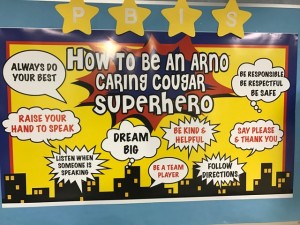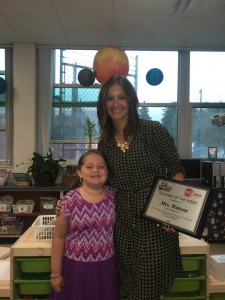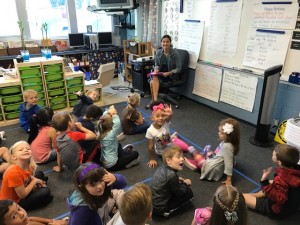Coming soon to Arno,
Oct. 3
Super Cougar Pizza Lunch 11:00
Jensen Goals 2:00
Teacher eval committee 4:00
Oct. 4
Steve @Riley 9:00
Oct 5
Steve @Traverse City- Barb Chuby is Teacher in Charge
Count Day
Oct 6
Steve @TC
Fall Picture Day
PTA Meeting 6:30
Oct 7
Steve @TC
Fun Run per schedule
Challenge

Congratulations!!!
What exciting news Arno received this past Monday. Our first grade teacher, Mrs. Dawn Watson received a “Teacher of the Week” Award from WNIC,
after being nominated by a parent. After finding out she won, Mrs. Watson had this to say “I am honored that one of my students nominated me for the WNIC Teacher of the Week. It is a pleasure and a privilege to work with the students at Arno. We get to learn, love and laugh together everyday! I get to see their faces light up and their big smiles when they’re successful. I get to help them when they struggle, pick them up when they fall, hug them when they’re not well and guide them through learning challenges. I am a lucky teacher indeed! In addition to working with my wonderful 1st grade classroom family I have THE BEST 1st grade teaching team and colleagues in the field. It is an honor to receive recognition for doing the work that I love and I look forward to celebrating with my colleagues and classroom family when WNIC comes to visit us on Thursday morning.”
Code Purple Clarification
Please be advised that the Purple cards in your classrooms are for exclusive use to notify the office or any other staff member that you need a Code Purple called for MEDICAL reasons only. If you have a behavior type emergency, you may call the office for my assistance- or call for Team NCI to come to your location. I will look into a Red Card to indicate an emergency other than medical for your room.
Goal Meetings
Please remember that there is an Oct. 31 deadline for the goal meetings to happen. I have met with several of you already, but not all. Observations will start mid-October
Keep Your Students Engaged with “Turn and Talk”
I am so happy to introduce Sally DeCost from Elementary Mattersbecause I pretty much love everything she writes and I would have been thrilled if she had taught my own kids. She does her research and she is tons-o-fun, so you will not want to miss this one.
what we can do as teachers to get the most we can out of the individual brains in our classrooms. It’s fascinating stuff!
Most of the information I’ve learned pretty much backs up what I already knew about teaching, but now there’s
evidence to back it up as good teaching practices!
to be learning. It’s called “Turn and Talk”. (Some call this “Think, Pair, Share”. Whole Brain
Teaching’s version is called “Teach, OK”.)
children immediately turn to face their assigned “turn and talk” partner, decide who will go first, and start a very active
conversation! I require my students to use as many gestures as they can, which I typically introduce before
the “turn and talk” time. (I tend to be very dramatic when I teach! No one could ever say I’m boring!) The
conversation goes back and forth until they’ve had enough time to review. The teacher then asks for volunteers
to share with the whole group, or the teacher simply shares what she heard partners say. This happens several
times during a lesson, keeping the students busy and engaged throughout the lesson.
away?) I’ve been known, after a “turn and talk” session, to say “this is what I heard…” But in reality, I didn’t hear
that, I just wanted the kids to think I heard it, because that’s what I wanted them to learn. It works every time,
and they never know!
won’t produce much learning-I’m sure you already figured that out!) Teachers need to give information
in “chunks”. Experts recommend no more than 2 – 4 chunks of information at a time. Then the learners
need time to process. Students need to take frequent breaks from listening and take time to process what they
are learning. They need to review and think about it.
fits the bill! I’ve seen this work from Kindergarten all the way through college, and beyond. Think about
your own professional development workshops and seminars: don’t you appreciate the opportunity to talk to
your peers and process the information?
peers grabs their attention. Show them how to sit “shoulder to shoulder, knee to knee”. Make it very clear
that they are to keep talking the whole time, even if they have to repeat what they’ve already said. Show the
children the importance of gesturing and mirroring the gestures. I also find they benefit from a demonstration
of “what NOT to do”! I’ve been know to be very amusing when I model that part! (If you make them laugh, they’llremember! That’s another aspect of brain based learning!)
if you prefer to call it “Think, Pair, Share”!
It’s been a pleasure to guest post for Rachel at Minds in Bloom!
Sally is a very experienced teacher of 36 years, having taught all grades from Preschool through 8th grade, except
4th. She has a B.S. in Elementary Education and a master’s degree inCreative Arts in Learning.
She has taught 2nd grade for several years now. She loves sharing her teaching experience and her passion for
brain based learning on her blog.at Elementary
Matters and selling at her Teachers Pay Teachers store. She also has a Pinterest board on Brain Research!

PTA Mad Science Night
From the Dry Ice bubbles to Bernoulli’s Principals on air pressure, Arno students got a fun look at how science works in our world. We had many families show up for the educational fun, and were able to enjoy cookies after the show compliments of the Arno PTA!











